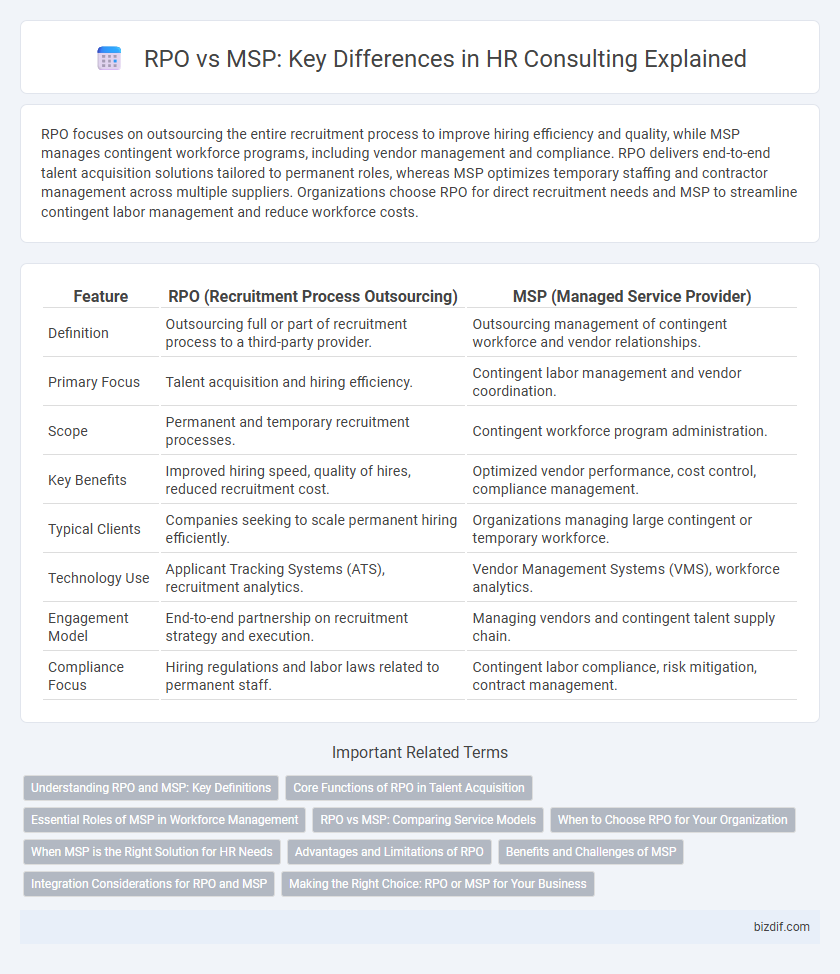RPO focuses on outsourcing the entire recruitment process to improve hiring efficiency and quality, while MSP manages contingent workforce programs, including vendor management and compliance. RPO delivers end-to-end talent acquisition solutions tailored to permanent roles, whereas MSP optimizes temporary staffing and contractor management across multiple suppliers. Organizations choose RPO for direct recruitment needs and MSP to streamline contingent labor management and reduce workforce costs.
Table of Comparison
| Feature | RPO (Recruitment Process Outsourcing) | MSP (Managed Service Provider) |
|---|---|---|
| Definition | Outsourcing full or part of recruitment process to a third-party provider. | Outsourcing management of contingent workforce and vendor relationships. |
| Primary Focus | Talent acquisition and hiring efficiency. | Contingent labor management and vendor coordination. |
| Scope | Permanent and temporary recruitment processes. | Contingent workforce program administration. |
| Key Benefits | Improved hiring speed, quality of hires, reduced recruitment cost. | Optimized vendor performance, cost control, compliance management. |
| Typical Clients | Companies seeking to scale permanent hiring efficiently. | Organizations managing large contingent or temporary workforce. |
| Technology Use | Applicant Tracking Systems (ATS), recruitment analytics. | Vendor Management Systems (VMS), workforce analytics. |
| Engagement Model | End-to-end partnership on recruitment strategy and execution. | Managing vendors and contingent talent supply chain. |
| Compliance Focus | Hiring regulations and labor laws related to permanent staff. | Contingent labor compliance, risk mitigation, contract management. |
Understanding RPO and MSP: Key Definitions
Recruitment Process Outsourcing (RPO) involves delegating partial or complete recruitment functions to an external provider to enhance talent acquisition efficiency and scalability. Managed Service Provider (MSP) manages contingent workforce programs, overseeing vendor management, procurement, and compliance to optimize temporary staffing. Understanding these distinctions is crucial for organizations seeking strategic workforce solutions tailored to permanent hiring or contingent labor management.
Core Functions of RPO in Talent Acquisition
RPO (Recruitment Process Outsourcing) primarily manages the end-to-end recruitment lifecycle, including candidate sourcing, screening, and onboarding, ensuring a seamless and scalable talent acquisition process. Core functions of RPO involve leveraging data-driven strategies and technology to enhance candidate quality, reduce time-to-hire, and improve employer branding. Unlike MSP, which focuses on contingent workforce management and vendor coordination, RPO delivers comprehensive recruitment solutions tailored to permanent hiring needs.
Essential Roles of MSP in Workforce Management
Managed Service Providers (MSPs) play a critical role in workforce management by overseeing contingent labor programs, ensuring compliance with labor laws, and optimizing vendor relationships to reduce costs and improve service delivery. MSPs centralize the management of temporary staffing, providing data analytics and reporting to enhance workforce planning and operational efficiency. Their essential functions include workforce strategy development, supplier management, and risk mitigation, ensuring organizations maintain a flexible and compliant contingent workforce.
RPO vs MSP: Comparing Service Models
RPO (Recruitment Process Outsourcing) specializes in managing the end-to-end recruitment process, delivering scalable talent acquisition solutions tailored to client needs. MSP (Managed Service Provider) focuses on managing contingent workforce programs, including vendor management and compliance for temporary staffing. Comparing service models, RPO drives full-cycle hiring efficiency while MSP optimizes contingent labor management, enabling organizations to strategically address permanent and contingent workforce demands.
When to Choose RPO for Your Organization
Choose RPO when your organization needs end-to-end recruitment management tailored to scale talent acquisition efficiently and improve candidate quality. RPO is ideal for companies facing high-volume hiring, seasonal workforce demands, or expanding into new markets with specialized roles. Opting for RPO enhances employer branding, reduces time-to-fill, and delivers strategic workforce insights aligned with long-term business goals.
When MSP is the Right Solution for HR Needs
MSP is the right solution for HR needs when a company requires comprehensive management of contingent workforce programs, including vendor management, compliance, and workforce analytics. Organizations with high volumes of temporary or contract labor benefit from MSP's ability to streamline supplier coordination and reduce procurement costs. This approach ensures improved visibility, enhanced risk mitigation, and optimized workforce utilization compared to traditional recruitment process outsourcing models.
Advantages and Limitations of RPO
RPO (Recruitment Process Outsourcing) offers scalability and access to specialized recruiting expertise, enhancing hiring efficiency and reducing cost-per-hire for companies facing fluctuating talent demands. However, RPO may present limitations such as potential loss of direct control over recruitment processes and the need for seamless integration with internal HR teams to maintain corporate culture alignment. While RPO excels in managing full-cycle recruitment, it may not be suitable for organizations requiring broader workforce management solutions covered by MSPs (Managed Service Providers).
Benefits and Challenges of MSP
Managed Service Provider (MSP) solutions streamline contingent workforce management by providing centralized vendor oversight, enhanced compliance tracking, and cost control, improving hiring speed and quality. Challenges include the complexity of integrating multiple vendors, potential loss of direct control over recruitment processes, and the need for robust data management systems to ensure visibility across all contingent labor sources. MSP partnerships deliver strategic workforce scalability and risk mitigation, but require careful vendor selection and ongoing collaboration to optimize outcomes.
Integration Considerations for RPO and MSP
Integration considerations for RPO and MSP involve aligning recruitment technology platforms and data management systems to ensure seamless candidate sourcing and vendor collaboration. RPO requires deep integration with internal HRIS and ATS systems for enhanced hiring workflows, while MSP demands robust connectivity with multiple suppliers and contingent workforce management tools. Successful integration optimizes reporting accuracy and compliance across the entire talent acquisition lifecycle.
Making the Right Choice: RPO or MSP for Your Business
Choosing between RPO and MSP hinges on your organization's hiring needs and workforce management goals. RPO offers end-to-end recruitment solutions, perfect for scalable talent acquisition and improving hiring efficiency, while MSP specializes in managing contingent workforce programs and vendor relationships for optimized temporary staffing. Aligning your business objectives with either RPO's full-cycle recruitment capabilities or MSP's vendor management expertise ensures strategic workforce optimization and cost control.
RPO (Recruitment Process Outsourcing) vs MSP (Managed Service Provider) Infographic

 bizdif.com
bizdif.com